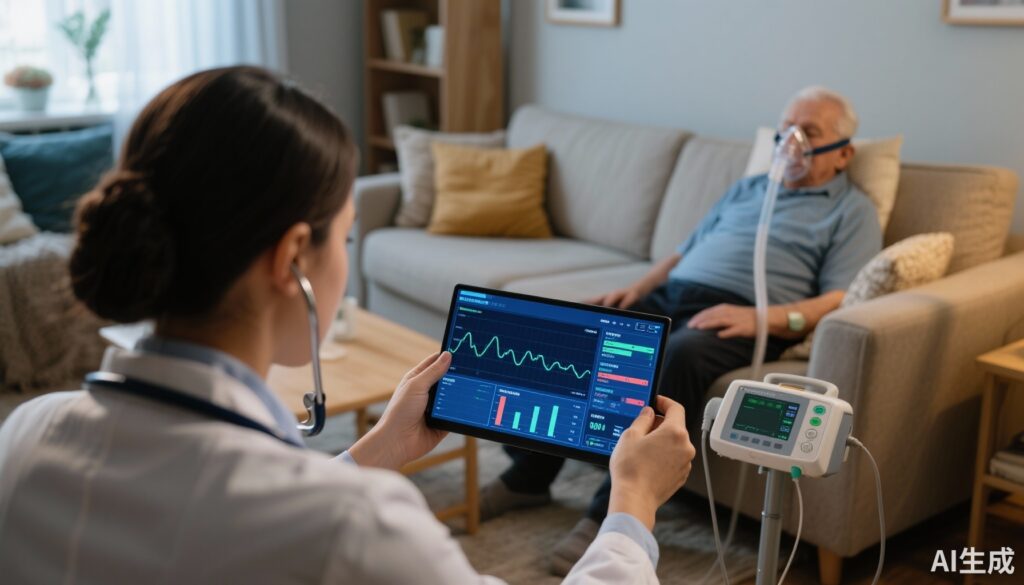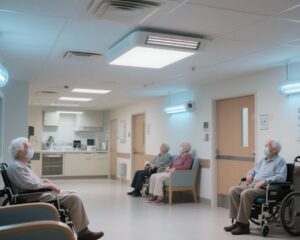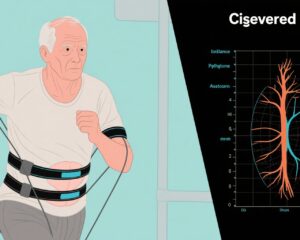Highlight
– The eVENT multicentre randomised trial evaluated the impact of a national French telemonitoring programme on home NIV effectiveness during follow-up.
– Telemonitoring with remote support did not significantly improve nocturnal transcutaneous CO2 but significantly lowered arterial CO2 levels and reduced hypercapnia.
– Telemonitoring was associated with better NIV adherence, more days with usage ≥4 hours, and fewer non-intentional leaks.
– Findings support integrating real-world telemonitoring programmes with therapeutic education to optimize home NIV outcomes.
Study Background and Disease Burden
Home non-invasive ventilation (NIV) is the cornerstone for managing chronic hypercapnic respiratory failure, common in conditions such as chronic obstructive pulmonary disease (COPD), obesity hypoventilation syndrome, and neuromuscular disorders. NIV improves gas exchange, reduces hospitalisations, and enhances quality of life. Despite established benefits, ensuring sustained NIV effectiveness remains challenging, particularly post-initiation when patients are remotely managed and adherence commonly declines.
Telemonitoring—remote surveillance of ventilator parameters and patient physiology—has gained traction to support initiation phases, but robust evidence regarding its role during longitudinal follow-up is scarce. A French national telemonitoring programme incorporating remote monitoring, algorithm-driven alerts, nurse-led therapeutic education, and support was designed to refine patient pathways and reduce healthcare resource utilisation. Evaluating this programme’s impact helps clarify its role in optimizing home NIV care in real-world settings.
Study Design
The eVENT trial was a prospective, multicentre, open-label, randomised controlled study (ClinicalTrials.gov identifier: NCT04615078) conducted in France. Adult patients recently (within 3 months) initiated on home NIV for chronic hypercapnic respiratory failure were recruited across multiple centres.
Participants were randomised 1:1 to either the telemonitoring group, receiving care through the national telemonitoring programme, or to usual follow-up comprising standard outpatient clinic visits and physician-led management.
In the telemonitoring arm, ventilator data—including adherence, leaks, and respiratory parameters—were transmitted remotely. A CE-marked software algorithm analysed data daily to generate alerts for pre-specified criteria. Expert nurses triaged alerts and provided targeted therapeutic education and advice to patients, supported by the multidisciplinary team.
The primary endpoint was the mean nocturnal transcutaneous carbon dioxide pressure (PtCO2) on NIV after 6 months. Secondary endpoints included room air arterial partial pressure of carbon dioxide (PaCO2), NIV adherence metrics (daily usage hours, days with >4 hours use), non-intentional leak rates, and proportion of patients without diurnal or nocturnal hypercapnia.
Key Findings
Fifty-six patients were randomised, with 53 included in the final analysis (27 in telemonitoring, 26 in usual care). After 6 months:
- Mean nocturnal PtCO2 levels were similar between telemonitoring and usual follow-up groups (42.1±6.1 vs 43.9±6.4 mm Hg; p=0.352), thus the primary endpoint was not met.
- However, telemonitoring patients exhibited significantly lower mean room air PaCO2 compared to controls (41.7±6.8 vs 46.2±3.5 mm Hg; p=0.003), indicating better overall daytime ventilatory efficacy.
- The proportion of patients free from diurnal or nocturnal hypercapnia at 6 months was markedly higher with telemonitoring (82.6%) versus usual care (27.3%) (p<0.001), a clinically meaningful difference.
- Adherence to NIV was greater in the telemonitoring group, evidenced by more days with usage ≥4 hours (statistically significant) and overall higher usage hours.
- Telemonitoring also reduced non-intentional mask leaks, improving ventilatory support quality and patient comfort.
These findings suggest telemonitoring with active remote support enhances home NIV therapy quality and patient adherence, contributing to superior daytime CO2 control.
Expert Commentary
This exploratory real-world study addresses an important gap in chronic respiratory failure management by focusing on home NIV follow-up—a period when patient support often diminishes. The benefits observed for daytime PaCO2 and hypercapnia reduction are particularly relevant, given that daytime hypercapnia relates directly to symptoms, exercise intolerance, and prognosis.
Although the primary endpoint of nocturnal PtCO2 did not differ significantly, the superior arterial gas improvements and adherence metrics underscore the clinical utility of remote monitoring combined with therapeutic education. Enhanced NIV use and reduced leaks likely contributed to improved gas exchange.
Some limitations include the modest sample size, which may affect statistical power for certain endpoints. The open-label design could introduce bias, although objective physiologic measures mitigate this concern. Additionally, socioeconomic factors influencing patient engagement with telemonitoring were not detailed.
Current guidelines recognize NIV follow-up challenges but offer limited direction on telemonitoring deployment. This study’s findings advocate integrating structured telemonitoring programmes with expert nurse support into routine home NIV care. Larger studies could further define cost-effectiveness and long-term clinical impacts, including hospitalizations and survival.
Conclusion
The eVENT trial demonstrates that a national telemonitoring programme with remote support and therapeutic education significantly improves daytime arterial CO2 control, reduces hypercapnia prevalence, and enhances home NIV adherence and ventilatory quality compared to usual care. These results support adopting real-world telemonitoring systems to optimize home NIV effectiveness during follow-up, potentially improving patient outcomes and reducing healthcare resource utilization. Further research is warranted to confirm long-term benefits and expand implementation strategies.
References
Prigent A, Texereau JB, Schmitz C, Ropars C, Degreef JM, Teulier M, Darne C, Lavergne F, Pasche H, Morelot-Panzini C. Real-world telemonitoring and remote support for home non-invasive ventilation to improve therapy effectiveness: the exploratory, multicentre randomised eVENT study. Thorax. 2025 Sep 15;80(10):720-729. doi: 10.1136/thorax-2024-222033. PMID: 40169180.


